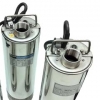
Guide To Selecting Submersible Pumps
By 4 Pumps|August 05, 2013
Are you considering a submersible pump, but unsure of which one to buy? With so many options on today’s market, it’s more important than ever to make informed choices. Buying an inadequate or unsuitable pump will only lead to watery headaches down the track. After all, pump-related problems, from breakdowns to leaks to blocks, are nobody’s idea of fun.
Three Types of Submersible Pumps
Submersible pumps fall into three categories: manual, automatic and vertical rigid automatic. Each functions slightly differently. Manual pumps can be switched on and off at the power point by the user. Automatic pumps, which are the traditional style, turn on automatically when the water rises to an appropriate level. This is achieved via a floating switch, attached to a swinging arm. Vertical rigid automatic pumps also switch on in response to rising water levels, but can function in shallower water than that demanded by a traditional automatic pump. Moreover, being comprised of a cylindrical tube containing magnets, rigid automatic pumps do not require external moving parts. They never become 'stuck' and are known for their reliability.
Materials and Manufacturing
When selecting a submersible pump, one of the crucial issues to consider is quality of materials and workmanship. Making a cheap purchase might be attractive to the wallet, but as the old adage goes, ‘You get what you pay for’. Durable, resilient pumps are usually made of high quality stainless steel, cast iron or hard plastic. On that note, buying from a trustworthy company is a must. I would advise seeking out a place that has a reputation for consistency and expertise, and has been in the business for years. Those who are highly experienced in stocking, distributing and installing pumps are likely to understand your specific situation better than those whose knowledge is limited.
Some Tips for Making the Right Choice
When considering if a particular pump will meet your needs, the first step is to check its ‘rated’ specs. The second is to determine the lowest and highest points that the related water will reach, and draw an imaginary vertical line between them. Thirdly, compare the length of this line with the pump’s specs. If this comparison reveals that the pump selected will be able to access the amount of water flow necessary to its successful functioning, then you’re heading in the right direction. Finally, you will need to decide which category of pump (of the three previously discussed) will suit you best.
Happy pumping!
Three Types of Submersible Pumps
Submersible pumps fall into three categories: manual, automatic and vertical rigid automatic. Each functions slightly differently. Manual pumps can be switched on and off at the power point by the user. Automatic pumps, which are the traditional style, turn on automatically when the water rises to an appropriate level. This is achieved via a floating switch, attached to a swinging arm. Vertical rigid automatic pumps also switch on in response to rising water levels, but can function in shallower water than that demanded by a traditional automatic pump. Moreover, being comprised of a cylindrical tube containing magnets, rigid automatic pumps do not require external moving parts. They never become 'stuck' and are known for their reliability.
Materials and Manufacturing
When selecting a submersible pump, one of the crucial issues to consider is quality of materials and workmanship. Making a cheap purchase might be attractive to the wallet, but as the old adage goes, ‘You get what you pay for’. Durable, resilient pumps are usually made of high quality stainless steel, cast iron or hard plastic. On that note, buying from a trustworthy company is a must. I would advise seeking out a place that has a reputation for consistency and expertise, and has been in the business for years. Those who are highly experienced in stocking, distributing and installing pumps are likely to understand your specific situation better than those whose knowledge is limited.
Some Tips for Making the Right Choice
When considering if a particular pump will meet your needs, the first step is to check its ‘rated’ specs. The second is to determine the lowest and highest points that the related water will reach, and draw an imaginary vertical line between them. Thirdly, compare the length of this line with the pump’s specs. If this comparison reveals that the pump selected will be able to access the amount of water flow necessary to its successful functioning, then you’re heading in the right direction. Finally, you will need to decide which category of pump (of the three previously discussed) will suit you best.
Happy pumping!


